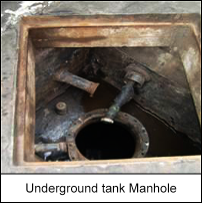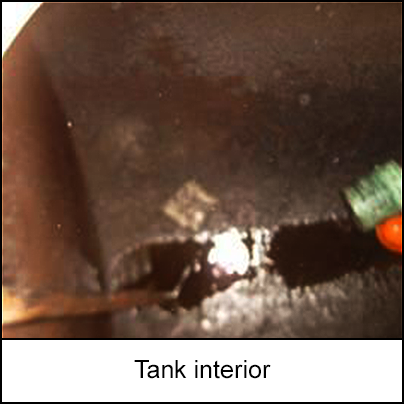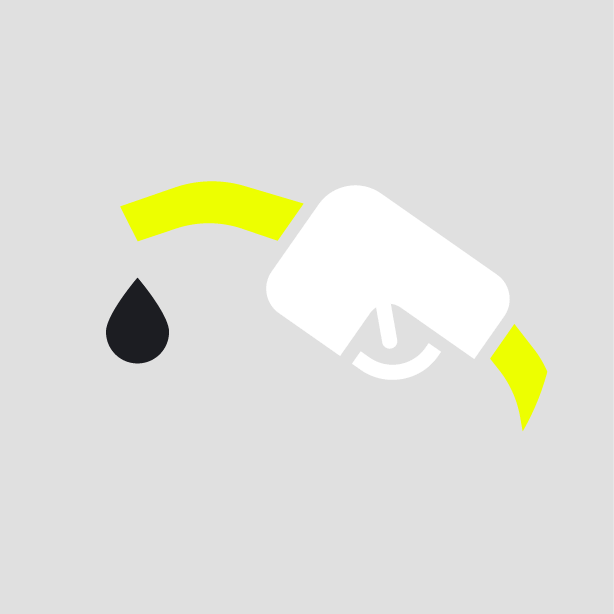-
What happened?
Two technicians and a supervisor (all experienced in this operation) were cleaning and degassing an underground kerosene tank prior to pressure testing.
The product was removed except for dead stock. The plan was to clean with soapy water and pump out the dead stock.
As a pump and water were not available, they decided to use an aluminium bucket attached to a string to remove the dead stock.
One of the workers, against his supervisor’s instruction, jumped into the tank and started scooping the remaining product at the bottom of the tank. He fainted. The second technician rushed inside to rescue him but also fainted.
The supervisor tied a rope around his chest and entered the tank. He rescued the second technician but fainted. He was dragged out by onlookers using the rope.
The first technician was removed by the fire brigade and pronounced dead.

-
Why did it happen?
Prevention plan and a permit to work had been prepared and authorised. Since there was no need to enter the tank, no entry permit was issued nor was gas detecting equipment provided.
Change of work scope: pump delayed and cleaning water not available on site.
Cause of fainting and death likely due to:
- Hydrocarbon vapours in high concentration can be toxic. They are also explosive.
- Lack of oxygen.
- Hydrogen sulphide: bacterial activity in sludges at the tank bottom may generate hydrogen sulphide - this is very toxic. In large quantities, it may not be possible to smell the ‘rotten egg’ smell of sulphur. This is a major hazard in hydrocarbon storage tanks.
- Other toxic gases: mainly the exhaust gases of vehicles in the gas station.

-
What did they learn?
Confined spaces and especially underground hydrocarbon storage tanks are hazards (risk of death).
Work procedures should minimise the need to enter into tanks.
If the operation can not be conducted as planned, it should be stopped.
Entering a confined space should require:
- A specific permit.
- An atmosphere control before entry.
- Protection measures, such as supervision and emergency evacuation plan.
For distillates (kerosene, diesel, fuel oils etc.) the risk of hydrogen sulphide must be always taken into account.
Do not attempt to rescue a person in a confined space if there is no means provided to rescue you.

-
Ask yourself or your crew
How can something like this happen here?
Why do you think the workers did what they did?
Think of a time you were doing a similar task but didn’t have the right equipment or plans changed. What did you do?
What is the plan for today’s job? What do we do if the plan changes?
What else can we learn from this incident?

Add to homescreen
Content name
Select existing category:
Content name
New collection
Edit collection
What happened?
Two technicians and a supervisor (all experienced in this operation) were cleaning and degassing an underground kerosene tank prior to pressure testing.
The product was removed except for dead stock. The plan was to clean with soapy water and pump out the dead stock.
As a pump and water were not available, they decided to use an aluminium bucket attached to a string to remove the dead stock.
One of the workers, against his supervisor’s instruction, jumped into the tank and started scooping the remaining product at the bottom of the tank. He fainted. The second technician rushed inside to rescue him but also fainted.
The supervisor tied a rope around his chest and entered the tank. He rescued the second technician but fainted. He was dragged out by onlookers using the rope.
The first technician was removed by the fire brigade and pronounced dead.

Why did it happen?
Prevention plan and a permit to work had been prepared and authorised. Since there was no need to enter the tank, no entry permit was issued nor was gas detecting equipment provided.
Change of work scope: pump delayed and cleaning water not available on site.
Cause of fainting and death likely due to:
- Hydrocarbon vapours in high concentration can be toxic. They are also explosive.
- Lack of oxygen.
- Hydrogen sulphide: bacterial activity in sludges at the tank bottom may generate hydrogen sulphide - this is very toxic. In large quantities, it may not be possible to smell the ‘rotten egg’ smell of sulphur. This is a major hazard in hydrocarbon storage tanks.
- Other toxic gases: mainly the exhaust gases of vehicles in the gas station.

What did they learn?
Confined spaces and especially underground hydrocarbon storage tanks are hazards (risk of death).
Work procedures should minimise the need to enter into tanks.
If the operation can not be conducted as planned, it should be stopped.
Entering a confined space should require:
- A specific permit.
- An atmosphere control before entry.
- Protection measures, such as supervision and emergency evacuation plan.
For distillates (kerosene, diesel, fuel oils etc.) the risk of hydrogen sulphide must be always taken into account.
Do not attempt to rescue a person in a confined space if there is no means provided to rescue you.
Ask yourself or your crew
How can something like this happen here?
Why do you think the workers did what they did?
Think of a time you were doing a similar task but didn’t have the right equipment or plans changed. What did you do?
What is the plan for today’s job? What do we do if the plan changes?
What else can we learn from this incident?
During tank cleaning, due to a pump not being available, a technician jumped inside a kerosene tank to scoop out remaining product. His colleagues jumped in to rescue him. One technician died, the other was rescued by the supervisor.












